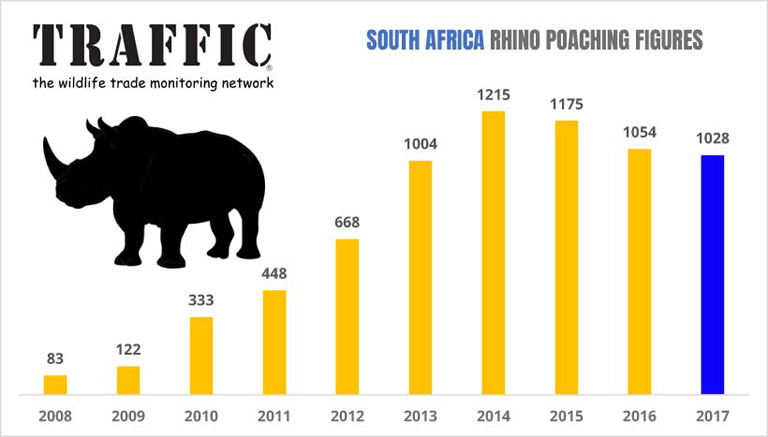- South African Minister of Water and Environmental Affairs Edna Molewa announced in a press briefing today that 1,028 rhinos were illegally killed in the country in 2017.
- In Kruger National Park, which has typically been the epicenter of rhino poaching in South Africa, 504 illegal killings were recorded last year, Molewa reported. That’s a 24 percent reduction over 2016 — but these gains were offset by poaching in other regions, particularly KwaZulu Natal province.
- While the rhino poaching rate in South Africa has slowly decreased every year since peaking in 2014 with 1,215 animals lost, conservationists were not encouraged by the slightly lower number of rhinos killed last year.
South African Minister of Water and Environmental Affairs Edna Molewa announced in a press briefing today that 1,028 rhinos were illegally killed in the country in 2017.
That figure represents a small decrease over 2016’s total of 1,054 illicit rhino killings.
Booming demand for rhino horn in newly-affluent Asian countries like Vietnam and China, where rhino horn is used in traditional medicine, is driving a poaching crisis that threatens to overturn the Southern white rhino population’s recovery from as low as 50 individuals in the early 20th century to about 20,000 today. The Southern white rhino is now the most abundant of all rhino subspecies, and South Africa is considered its last stronghold.
In Kruger National Park, which has typically been the epicenter of rhino poaching in South Africa, 504 illegal killings were recorded last year, Molewa reported. That’s a 24 percent reduction over 2016 — but these gains were offset by poaching in other regions, particularly KwaZulu Natal province.

Meanwhile, arrests of suspected rhino poachers and traffickers in South Africa dropped by almost a quarter, with just 518 last year compared to 680 in 2016.
Molewa also reported a rise in the number of elephants poached in Kruger National Park, as 67 elephants were killed there in 2017. According to Reuters, South Africa’s Department of Environmental Affairs said in a statement that “The increases in other provinces, coupled with the sharp rise in elephant poaching, tell us that as we progress and evolve, so do the tactics and methods of the poachers.”
Indeed, it was reported last year that transnational criminal networks have begun manufacturing jewelry, beads, and other trinkets out of rhino horn in southern Africa rather than smuggling the horns out of the continent whole or in chunks, a new tactic that could possibly be helping illegal exports evade detection.
South Africa imposed a moratorium on domestic trade in rhino horn in 2009, but the country’s constitutional court overruled a governmental appeal to keep the ban in place in April of last year. Legal auctions of rhino horn subsequently resumed a few months later. (International trade in rhino horns was banned by the Convention on International Trade in Endangered Species of Fauna and Flora (CITES) in 1977, and that ban remains in place.)
While the rhino poaching rate in South Africa has slowly decreased every year since peaking in 2014 with 1,215 animals lost, conservationists were not encouraged by the slightly lower number of rhinos killed last year.
“The marginally lower total in 2017 still remains unacceptably high,” Tom Milliken, Rhino Programme Leader for TRAFFIC, the wildlife trade monitoring network, said in a statement. Milliken noted that 1,028 total killings works out to nearly three rhinos poached every day in South Africa last year: “the bottom line is the crisis continues unabated.”
Milliken also noted that South Africa has yet to formally adopt its National Integrated Strategy to Combat Wildlife Trafficking. “TRAFFIC calls on South Africa urgently to adopt and implement its national strategy to combat wildlife trafficking: the potential growth of new markets for rhino products is a deeply worrying development that needs to be nipped in the bud — we’re far from seeing the light at the end of this very long, dark tunnel,” he said.
At the press conference this morning announcing the 2017 rhino poaching data, Minister Molewa acknowledged that there was much work yet to be done to rein in the poaching crisis that is decimating Africa’s rhino and elephant populations, but struck a note of optimism in response to the progress that has been made.
According to a tweet by the South African government’s official Twitter account, Molewa said, “It is clear from what we have reported to you as a team this morning that we continue to register successes in our fight against rhino poaching, but we are equally aware that the battle is far from won.”
She added: “We will in 2018 continue to draw on our achievements, learn from our mistakes, and adapt international best practice. It is only through a collaborative approach that we have come this far — which is a long way from where we were a few years ago.”

FEEDBACK: Use this form to send a message to the author of this post. If you want to post a public comment, you can do that at the bottom of the page.
